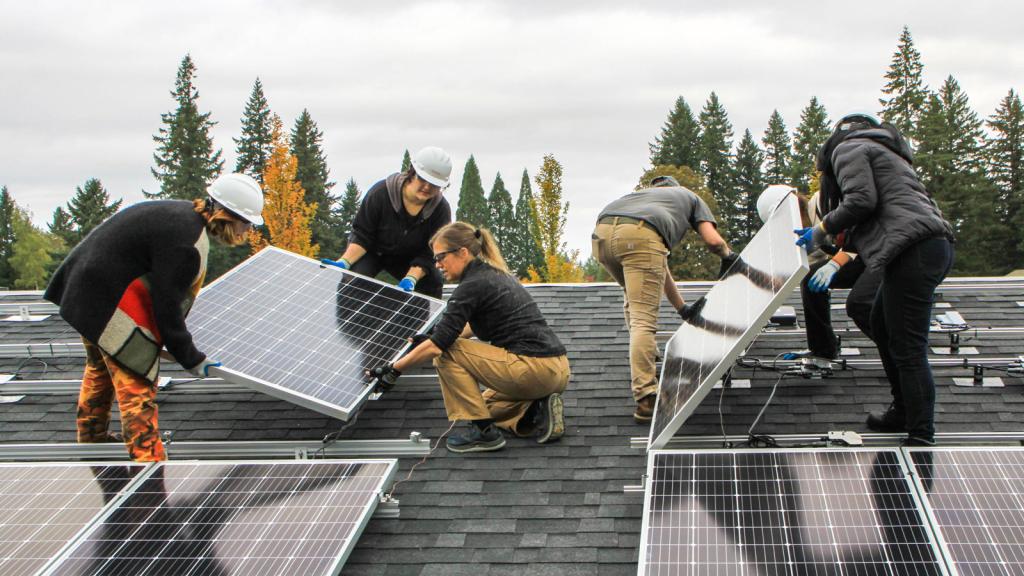Laurie Schoeman is director for resilience and climate risk reduction in capital at Enterprise Community Partners, a national affordable-housing nonprofit. Ryan Colker is vice president of innovation at the International Code Council and executive director of the Alliance for National & Community Resilience.
In March, the Federal Emergency Management Agency rated each state’s building codes on how well they help newly built and retrofitted homes stand up to disaster. Thirty-nine states landed in the lowest category of resistance to hazards, meaning less than 25 percent of communities in each state have building codes that provide adequate resilience. Nineteen states scored zero out of 100, meaning no communities had codes that met these criteria, leaving residents vulnerable.
When disasters strike, they leave homes destroyed and lives shattered in their wake. Since 1980, major hurricanes, wildfires, and flooding have caused more than $2 trillion in damage. And every year, the federal government invests billions to help communities rebuild. Yet some of these investments are lost once again to subsequent disasters, fueled by climate change, because many states do not have requirements for resiliency.
This is especially worrisome for federally assisted housing programs, which defer to local construction requirements; that means they may follow building codes that are decades old, if they exist at all (about two-thirds of the country does not have hazard-resistant codes, and about 30 percent of construction activity occurs in locations with no codes or codes that date back to before the turn of the century).
As taxpayers, we should expect those dollars to be used in a more efficient and effective way. And as climate activists, we need to consider the incalculable impacts on the people whose lives and livelihoods are derailed while they rebuild, especially residents of federally supported housing.
We know that more frequent and destructive disasters are on the horizon. We also know that disasters hit low- and moderate-income families the hardest: Only about four in 10 Americans can afford to cover an unanticipated $1,000 expense, and low- and moderate-income families are more likely to live in disaster-prone areas in the first place.
The construction industry knows how to build climate-resilient homes. For example, vegetation and landscaping choices can minimize the risk of wildfires reaching a home; heating and cooling equipment placed on the roof instead of in the basement assures residents don’t lose critical utilities in flood-prone areas; and tie-downs ensure roofs won’t blow off in high winds. The challenge is that, according to FEMA, most local building codes have not kept up to date with advancements in technology and building science. Too many communities have no standards whatsoever.
The Biden administration has said it wants to start being proactive when it comes to disaster resiliency — and now is the time. The Department of Housing and Urban Development and the Department of Agriculture have the authority and capability to set requirements for the design, construction, and operation of federally funded housing, and the agencies are currently going through the process of reviewing and updating their energy efficiency standards and goals.
While making these changes, they should also set consistent resilience standards based on current model building codes. If housing is no longer habitable after a storm, any energy efficiency improvements will be lost. Resilience and sustainability must go hand in hand.
Projects receiving FEMA funding are already required to adhere to up-to-date international codes and standards. For instance, in California, a developer rebuilding from a wildfire would use more fire-resistant materials instead of cedar shakes in roofing and siding, and take measures to reduce the chance for embers to enter through the eaves.
But much of federally supported housing in disaster-prone areas is funded by HUD and the USDA, which have no such requirements. FEMA projects that if all future construction (not just federally funded) followed suit, the U.S. would avoid more than $600 billion in cumulative losses from floods, hurricanes, and earthquakes by 2060. On top of this, thousands of families every year would be spared the pain of losing their home to a disaster.
Homes must be built to withstand the changing climate. No, not every home will survive a disaster, even if built to the best codes. But strategic choices in materials, design, and landscaping can make a significant difference. Yes, they may cost more on the front end, but they have long-term benefits for investors, homeowners, and communities. The National Institute of Building Sciences estimates that modern building codes save $11 for every $1 invested through earthquake-, flood-, and wind-mitigation benefits, and retrofitting 2.5 million homes to wildfire codes could provide a nationwide benefit-cost ratio as high as 8 to 1.
It seems like a no-brainer. Why hasn’t this already happened?
Let’s face it: Building codes and standards is a wonky topic that most people don’t think about. A survey by the Federal Alliance for Safe Homes found that about 70 percent of people thought their local building code was completely or relatively up to date, when in reality it might be old or nonexistent. Many renters and homeowners also falsely assume that government policies already protect them, which may explain why there hasn’t been massive consumer demand to push the industry to change. Further, the people most impacted by old or nonexistent codes may have less time or resources to engage.
While architects and engineers know how to build resilient structures, the lack of developer or resident demand limits their ability to deliver it. Absent minimum, consistent federal standards, most federally supported housing will be built without the benefit of the latest hazard resistant requirements.
There is precedent to hold the construction industry to such standards. The U.S. Department of Energy sets efficiency minimums for heating, ventilation, and air-conditioning equipment, as well as many other appliances, saving consumers $321 on energy bills annually. Beyond these, the EnergyStar program drives manufacturers and consumers to create even more efficient products. Though participation is voluntary, the widely recognized label and the movement it represents have saved more than $450 billion and reduced greenhouse gas emissions by 4 billion metric tons.
HUD and USDA must move quickly to adopt resiliency standards. It’s a simple step, but one that will ripple through the entire housing industry for the better.
The views expressed here reflect those of the authors.
Fix is committed to publishing a diversity of voices, and we want to hear from you. Got a bold idea, fresh perspective, or insightful news analysis? Send a draft, along with a note about who you are, to opinions@grist.org.




